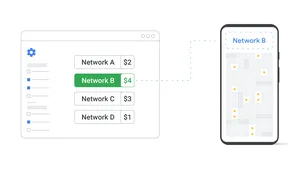Best practices to optimize AdMob demand to earn more

A top request we get from app publishers is to provide guidance on how to achieve the optimal mediation setup to maximize ads revenue. This can be a daunting task as it requires careful and continuous experimentation. Changing advertiser behaviors, seasonality, and traffic fluctuation also play a role in how you should configure network rankings and CPM assignments in your waterfall.
In this post, we will share some best practices to help you optimize mediation setup and get the most out of the AdMob network.
Maximize inventory value by increasing competition in the mediation stack
Creating sufficient competition in your mediation stack is key to earning more revenue from your ad network partners, including AdMob. Below are some general guidelines to help you get there.
- Analyze network performance using historical data to understand the baseline value of each network. Remember to segment by format and geography because it is likely that your winning network will vary by region.
- Group ad sources with similar eCPM together in your waterfall. This will drive up network competition most effectively to help you maximize yield.
- Monitor network performance and adjust ranking based on how they’re performing. For example, if certain networks are trending downward, switch them with other networks that are trending up.
- Swap ad network positioning in your waterfall to understand which ad network can produce higher expected revenue, then order your waterfall accordingly to earn more.
Optimize performance of the AdMob network with multiple calls
Multiple calls is the practice where app publishers call the same network multiple times for a single ad request as a way to maximize inventory access and earn more. When working with AdMob mediation, we recommend using Ad Network Optimization (ANO) as it can help you optimize revenue across multiple networks automatically. The AdMob network allows up to three calls for the same ad request. For publishers who are interested in calling Google from third-party mediation platforms, below are some general guidelines.
- Set up three baseline calls to test high, middle, and low price tiers. For the high-tier call, place it at the very top of your waterfall. We recommend setting a floor price at the same CPM as your highest line-item. For the medium-tier call, place it at about 50 percent of the top call’s floor price. As for the low-tier call, place it near the bottom of the waterfall to allow Google to fill at almost any floor price.
- Make sure there’s an adequate range of CPM price difference between the calls to drive up the floor price effectively instead of adding more calls.
- Continue to test floor prices and ad formats with a small percentage of your inventory to capture any upward trends to earn more.
As we can see from the above, this approach requires a lot of time commitment from publishers. If you’re looking to reduce time spent optimizing your performance, we recommend taking advantage of the AdMob platform. We offer many built-in features to help you optimize demand across Google and many other ad network partners more effectively. Instead of making manual updates to manage the waterfall, you can turn on ANO to automate that process. Mediation a/b testing is another great feature for you to test and refine your waterfall setup. AdMob also offers an in-app real time bidding solution called bidding to help publishers maximize revenue. If you’re interested to know more about bidding or the a/b testing feature, please talk to your account manager. To get started with mediation, simply log in to your AdMob account.





